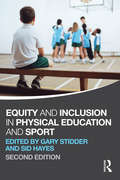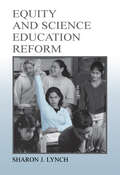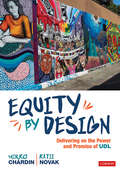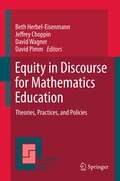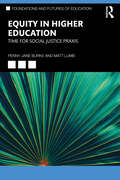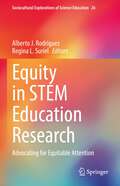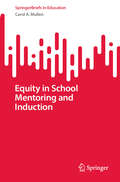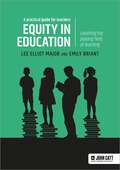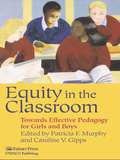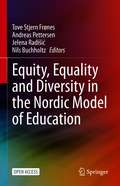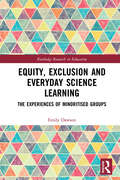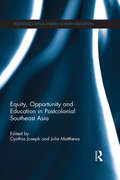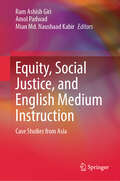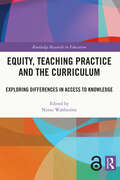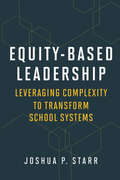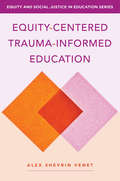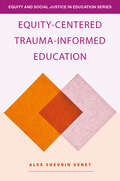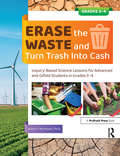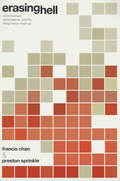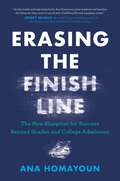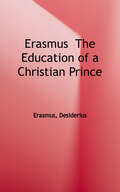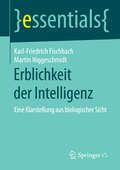- Table View
- List View
Equity and Inclusion in Physical Education and Sport (2nd Edition)
by Gary Stidder Sid HayesAn essential component of good practice in physical education is ensuring inclusivity for all pupils, regardless of need, ability or background. Now in a fully revised and updated new edition, Equity and Inclusion in Physical Education fully explores the theoretical and practical issues faced by physical education teachers today. The book amalgamates areas of critical debate within the world of physical education and is structured around the key topics of ability, special educational needs, gender, sexuality, social class, race and ethnicity. These issues are discussed in relation to principles of equity, equality of opportunity, pedagogy, differentiation, curriculum planning and cultural awareness. Other chapters explore contemporary themes such as healthism and obesity and values in physical education and policy, whilst a chapter new to this edition demonstrates the importance of reflexivity and critical self-reflection in good inclusive practice. As well as being a perfect introductory text for any course on inclusion or inclusive practice in physical education, the book offers invaluable, practical advice for established professionals, newly qualified teachers and trainees about how to meet equity and inclusion requirements. Examples of good practice are included throughout, as well as guidance on how to implement an inclusive PE curriculum within the school.
Equity and Science Education Reform
by Sharon J. LynchThis lucid, accessible, thought-provoking discussion of issues related to equity in science education reform is for science educators, including idealists and exacting pragmatists, who are dedicated to exploring what it means to put into practice rallying cries like "science literacy for all," "equity and excellence," and "standards-based reform." Intended as an enjoyable and stimulating read, as opposed to a comprehensive summary of everything ever written about equity in science education, it is a response to the new science education standards and reforms, with their goal of science literacy for all. If this goal is to be taken seriously, the implications are immense. A central purpose of this book is to project and discuss how achieving this goal would affect science education reform and vice versa. The work is research based, using statistics, tables, and figures drawn primarily from NSF reports and other public information documents to provide a foundation for equity concerns. However, these statistics are not the main focus of the book. Rather, they are used to make a case, backed by pertinent research, the literature on best practice, and provocative examples from schools and classrooms. Charts, tables, and graphic organizers provide visual evidence and enhance the arguments presented. Moving from research-based studies to classroom stories, Equity and Science Education Reform encourages readers to think about the complexity of the issues. No easy answers or quick fixes are offered. Researching across "identity" areas and attempting to unite them in a discussion that recognizes both the common elements as well as important distinctions, it provides a comprehensive picture of equity concerns across ethnicity, class, gender, and location. Encompassing a broad literature in science education, reform and policy, and equity issues, it offers an "equity schema" as a unifying concept to guide discussion throughout. This book is based, in part, on a series of nine background papers that were commissioned by the American Association for the Advancement of Science's Project 2061 and the summary document, which was written by the author of this book. But it goes far beyond the original study to provide a consistent, coherent, and lively discussion that vividly illustrates the issues raised by the experiences of teachers and students who are struggling with equity principles in the context of science education reform.
Equity by Design: Delivering on the Power and Promise of UDL
by Mirko Chardin Katie R. Novak"Our calling is to drop our egos, commit to removing barriers, and treat our learners with the unequivocal respect and dignity they deserve." --Mirko Chardin and Katie Novak When it comes to the hard work of reconstructing our schools into places where every student has the opportunity to succeed, Mirko Chardin and Katie Novak are absolutely convinced that teachers should serve as our primary architects. And by "teachers" they mean legions of teachers working in close collaboration. After all, it’s teachers who design students’ learning experiences, who build student relationships . . . who ultimately have the power to change the trajectory of our students’ lives. Equity by Design is intended to serve as a blueprint for teachers to alter the all-too-predictable outcomes for our historically under-served students. A first of its kind resource, the book makes the critical link between social justice and Universal Design for Learning (UDL) so that we can equip students (and teachers, too) with the will, skill, and collective capacity to enact positive change. Inside you’ll find: Concrete strategies for designing and delivering a culturally responsive, sustainable, and equitable framework for all students Rich examples, case studies, and implementation spotlights of educators, students (including Parkland survivors), and programs that have embraced a social justice imperative Evidence-based application of best practices for UDL to create more inclusive and equitable classrooms A flexible format to facilitate use with individual teachers, teacher teams, and as the basis for whole-school implementation "Every student," Mirko and Katie insist, "deserves the opportunity to be successful regardless of their zip code, the color of their skin, the language they speak, their sexual and/or gender identity, and whether or not they have a disability." Consider Equity by Design a critical first step forward in providing that all-important opportunity. Also From Corwin: Hammond/Culturally Responsive Teaching & the Brain: 9781483308012 Moore/The Guide for White Women Who Teach Black Boys: 9781506351681 France/Reclaiming Professional Learning: 9781544360669
Equity by Design: Delivering on the Power and Promise of UDL
by Mirko Chardin Katie R. Novak"Our calling is to drop our egos, commit to removing barriers, and treat our learners with the unequivocal respect and dignity they deserve." --Mirko Chardin and Katie Novak When it comes to the hard work of reconstructing our schools into places where every student has the opportunity to succeed, Mirko Chardin and Katie Novak are absolutely convinced that teachers should serve as our primary architects. And by "teachers" they mean legions of teachers working in close collaboration. After all, it’s teachers who design students’ learning experiences, who build student relationships . . . who ultimately have the power to change the trajectory of our students’ lives. Equity by Design is intended to serve as a blueprint for teachers to alter the all-too-predictable outcomes for our historically under-served students. A first of its kind resource, the book makes the critical link between social justice and Universal Design for Learning (UDL) so that we can equip students (and teachers, too) with the will, skill, and collective capacity to enact positive change. Inside you’ll find: Concrete strategies for designing and delivering a culturally responsive, sustainable, and equitable framework for all students Rich examples, case studies, and implementation spotlights of educators, students (including Parkland survivors), and programs that have embraced a social justice imperative Evidence-based application of best practices for UDL to create more inclusive and equitable classrooms A flexible format to facilitate use with individual teachers, teacher teams, and as the basis for whole-school implementation "Every student," Mirko and Katie insist, "deserves the opportunity to be successful regardless of their zip code, the color of their skin, the language they speak, their sexual and/or gender identity, and whether or not they have a disability." Consider Equity by Design a critical first step forward in providing that all-important opportunity. Also From Corwin: Hammond/Culturally Responsive Teaching & the Brain: 9781483308012 Moore/The Guide for White Women Who Teach Black Boys: 9781506351681 France/Reclaiming Professional Learning: 9781544360669
Equity for Women in Science: Dismantling Systemic Barriers to Advancement
by Cassidy R. Sugimoto Vincent LarivièreThe first large-scale empirical analysis of the gender gap in science, showing how the structure of scientific labor and rewards—publications, citations, funding—systematically obstructs women’s career advancement.If current trends continue, women and men will be equally represented in the field of biology in 2069. In physics, math, and engineering, women should not expect to reach parity for more than a century. The gender gap in science and technology is narrowing, but at a decidedly unimpressive pace. And even if parity is achievable, what about equity?Equity for Women in Science, the first large-scale empirical analysis of the global gender gap in science, provides strong evidence that the structures of scientific production and reward impede women’s career advancement. To make their case, Cassidy R. Sugimoto and Vincent Larivière have conducted scientometric analyses using millions of published papers across disciplines. The data show that women are systematically denied the chief currencies of scientific credit: publications and citations. The rising tide of collaboration only exacerbates disparities, with women unlikely to land coveted leadership positions or gain access to global networks. The findings are unequivocal: when published, men are positioned as key contributors and women are relegated to low-visibility technical roles. The intersecting disparities in labor, reward, and resources contribute to cumulative disadvantages for the advancement of women in science.Alongside their eye-opening analyses, Sugimoto and Larivière offer solutions. The data themselves point the way, showing where existing institutions fall short. A fair and equitable research ecosystem is possible, but the scientific community must first disrupt its own pervasive patterns of gatekeeping.
Equity in Discourse for Mathematics Education
by David Wagner Beth Herbel-Eisenmann David Pimm Jeffrey ChoppinThis book explores the connection between the ways people speak in mathematics classrooms and their opportunities to learn mathematics. The words spoken, heard, written and read in mathematics classrooms shape students' sense of what mathematics is and of what people can do with mathematics. The authors employ multiple perspectives to consider the means for transformative action with respect to increasing opportunities for traditionally marginalized students to form mathematical identities that resonate with their cultural, social, linguistic, and political beings.
Equity in Higher Education: Time for Social Justice Praxis (ISSN)
by Penny Jane Burke Matt LumbIn a global context of growing inequality and socio-environmental crises, Equity in Higher Education considers the issues and challenges for progressing an equity agenda.It advances a unique multidimensional framework based on theoretical and conceptual threads, including critical, feminist, decolonial, post-structural, and sociological discourses. It also provides readers with the sophisticated insights and tools urgently needed to challenge long-standing, entrenched, and insidious inequalities at play in and through higher education.Written as a form of a pedagogical interaction, and addressing nuanced temporal and spatial inequalities, this key resource will be of value to policymakers, practitioners, educators, and scholars committed to progressive and groundbreaking approaches that can engage the ongoing challenges of transforming higher education towards more just realities.
Equity in STEM Education Research: Advocating for Equitable Attention (Sociocultural Explorations of Science Education #26)
by Alberto J. Rodriguez Regina L. SurielThis book focuses on the creative and transformative work of scholars who are advancing social justice through science/STEM education with limited resources. It draws attention to the significant body of work being conducted in various contexts so that readers could reflect and appreciate how much broader and transformative our impact could be if funding agencies, policy makers, and other researchers would widen their perspective and seek to promote social justice-driven scholarship. Public funding for STEM research on K-12 and teacher education that targets special populations is often limited and tends to favor mainstream research. This book contains case studies on innovative and promising STEM research with a focus on equity, diversity and social justice that are funded with limited or no public funding. It also presents anecdotes from authors in relation to their struggles in either securing funding for their reported study or seeking to publish its findings. This provides more context to the challenges of conducting non-mainstream research in science/STEM education. Most of the contributors are scholars of color and/or women conducting research with traditionally marginalized populations in science/STEM. Thus, this book offers an additional venue to share the voices of marginalized scholars and allies seeking to broaden our understanding of the challenges and successes of promoting equity, diversity, and social justice in various educational contexts.
Equity in School Mentoring and Induction (SpringerBriefs in Education)
by Carol A. MullenThis book provides an original mentoring/induction framework that spotlights equity in schools. In it, support-accessibility-collaboration-equity (SACE) is presented as a powerful structure for re-imagining mentoring/induction, especially for busy practitioners. Current mentoring models refer to the three pillars of support, accessibility, and collaboration (SAC). This book introduces an additional perspective, that is, the aspect of equity/justice in regard to career entry and socialization. The SACE framework extends the SAC model and fills a gap in the literature. Schools that integrate equity in mentoring/induction can anticipate the equitable support of new teachers, among other benefits. This research-informed work offers accessible theory on an important issue in the world of practice. The focus is on equity, a much-neglected area in mentoring/induction knowledge. Additionally, practical activities and case studies bring theory to life in everyday professional practice. This reader-friendly book appeals to a wide, global audience and is useful for early career teachers, mentors, teacher educators, and policymakers. It is of particular interest to those with a passion for social justice and equity in professional contexts. Practitioners seeking ways to improve their program design and delivery from an equity perspective can draw on this resource for their own purposes. University teachers and students in educational leadership and teacher education programs and mentoring/induction researchers can explore the book’s social justice ideas to enrich theory and practice.
Equity in education: Levelling the playing field of learning - a practical guide for teachers
by Lee Elliot Major Emily Briant'Comprehensive and groundbreaking.' Dylan WiliamEquity in Education sets out a new equity-based approach in education to help teachers improve the prospects of under-resourced and working-class pupils.The equity approach recognises that we must address our own cultural biases and barriers within the classroom, while helping to remove extra barriers to learning experienced by children outside schools. Based on thousands of research studies and years of working with expert teachers, the book sets out the principles and practical strategies for trainee teachers, teachers and teacher leaders.Adopting an equity mindset involves four key principles:· equity not equality - doing more to overcome the extra barriers some learners experience· capacity not deficit thinking - recognising the talents in all pupils· deep not shallow relationships - developing authentic individual relationships with pupils· multiple not singular talents - acknowledging that human talents come in many forms.Equity in Education also advocates the national policies that would enable teachers to prioritise an equitable approach and reduce divides between the education haves and have-nots.
Equity in education: Levelling the playing field of learning - a practical guide for teachers
by Lee Elliot Major Emily Briant'Comprehensive and groundbreaking.' Dylan WiliamEquity in Education sets out a new equity-based approach in education to help teachers improve the prospects of under-resourced and working-class pupils.The equity approach recognises that we must address our own cultural biases and barriers within the classroom, while helping to remove extra barriers to learning experienced by children outside schools. Based on thousands of research studies and years of working with expert teachers, the book sets out the principles and practical strategies for trainee teachers, teachers and teacher leaders.Adopting an equity mindset involves four key principles:· equity not equality - doing more to overcome the extra barriers some learners experience· capacity not deficit thinking - recognising the talents in all pupils· deep not shallow relationships - developing authentic individual relationships with pupils· multiple not singular talents - acknowledging that human talents come in many forms.Equity in Education also advocates the national policies that would enable teachers to prioritise an equitable approach and reduce divides between the education haves and have-nots.
Equity in the Classroom: Towards Effective Pedagogy for Girls and Boys
by Caroline V. GippsConcerned with pedagogy and the learning achievement of both girls and boys, this book examines international trends in subject performance throughout schooling and looks critically at a range of interventions in difference contexts and countries, all aimed at enhancing equity in schools and higher education institutions.; The book argues that pedagogy can not be isolated from the overarching gender-education system. What can be done, it claims, is that teachers can be provided with a range of pedagogic strategies which can be used to make education, as it is experienced by students and reflected in their achievements, more just.
Equity, Equality and Diversity in the Nordic Model of Education
by Tove Stjern Frønes Andreas Pettersen Jelena Radišić Nils BuchholtzDoes the Nordic model of education still stand by its original principles and safeguard education for all? This Open Access volume is a carefully crafted collection of chapters that investigate the different aspects of equity, equality and diversity across the education systems in the Nordic countries. Based on data from various national and international large-scale assessments, the volume provides a better understanding of both the functions and foundations of the Nordic model, along with how the concepts mentioned above are enacted in practice. Across the chapters, data from different national and international large-scale assessment studies are used for cross- and single-country analyses on a variety of issues related to equity, equality and inequality in diverse educational settings. The investigations address different subject domains (i.e., mathematics, science, reading), age and grade groups, but also issues related to teachers and the schools themselves. In addition to these empirical chapters, the book addresses the theoretical and methodological underpinnings of the ideas and tools embedded in the phenomena of equity and equality and how they have met in the Nordic model of education.
Equity, Exclusion and Everyday Science Learning: The Experiences of Minoritised Groups (Routledge Research in Education)
by Emily DawsonEquity, Exclusion and Everyday Science Learning explores how some people are excluded from science education and communication. Taking the role of science in society as a starting point, it critically examines the concept of equity in science learning and develops a framework to support inclusive change. This book presents a theoretically informed, empirically detailed analysis of how people from minoritised groups in the UK experience science and everyday science learning resources in their daily lives. The book draws on two years of ethnographic research carried out in London with five community groups who identified as Asian, Somali, Afro-Caribbean, Latin American and Sierra Leonean. Exploring their experiences of everyday science learning from a sociological perspective, with social justice as a guiding concern, this book opens with a theory of exclusion and closes with a theory of inclusion. Equity, Exclusion and Everyday Science Learning is not only an essential text for postgraduate students and postdoctoral researchers of Science Education, Science Communication and Museum Studies, but for any professional working in museums, science centres and institutional public engagement.
Equity, Opportunity and Education in Postcolonial Southeast Asia (Routledge Critical Studies in Asian Education)
by Cynthia Joseph Julie MatthewsEquity, Opportunity and Education in Postcolonial Southeast Asia addresses the ways in which colonial histories, nationalist impulses and forces of globalization shape equity and access to education in Southeast Asia. Although increasingly identified as a regional grouping (ASEAN), Malaysia, Indonesia, Burma, Thailand, Singapore and the Philippines are known for their vastly different state structures, political regimes, political economies and ethnocultural and religious demography. The expert contributors to this volume investigate educational access and equity for citizens, ethnic and religious minorities, and indigenous people within these countries. The subject of education is framed within the broader national and local challenges of achieving equity and social justice. This book examines the dimensions of (post)colonialism, nationalism, and globalisation as played out within different international educational contexts. Chapters include: Understanding the Cultural Politics of Southeast Asian Education through Postcolonial Theory Downplaying Difference: Representations of Diversity in Contemporary Burmese Schools and Educational Equity Learner Centered Pedagogy in Post-Conflict Timor-Leste: For the Benefit of the Learner or the Learned Technology of Dominance, Technology of Liberation: Education in Colonial and Postcolonial Cambodia Change and Continuity in the History of Vietnamese Higher Education Colonization by Stealth: The Case of Thailand Education Politics in Postcolonial Malaysia: Ethnicity, Difference and Inequalities The Singapore Education Journey: From Colonialism to Globalism
Equity, Social Justice, and English Medium Instruction: Case Studies from Asia
by Ram Ashish Giri Mian Md. Naushaad Kabir Amol PadwadThis book contributes to the existing body of knowledge on English Medium Instruction's (EMI) role in equity and social justice and adds to the ongoing conversation by providing the Asian perspective to it. It showcases scholarly works by scholars and researchers in the field and presents their diverse voices on EMI and social justice in a single volume. This book focuses on different aspects of the issue on EMI, equity, and social justice in different Asian contexts while providing a holistic picture of social justice in English language teaching in the region. It focuses on the current context-specific EMI practices situating them in their historical pretext, employs prevalent theoretical as well as methodological models and approaches to study such practices, considers curricular and pedagogical considerations adapted to address the multitude of needs of EMI, and examines controversies surrounding the conceptualization, plan/policy, and implementation strategies of EMI.
Equity, Teaching Practice and the Curriculum: Exploring Differences in Access to Knowledge (Routledge Research in Education)
by Ninni WahlströmThis book explores how different classroom discourses and concepts of knowledge permeate teaching in high- and low-performance classrooms. Drawing on empirical research from classrooms in Sweden, it presents a theory-based framework for classroom research. The book examines the central concepts of knowledge, curriculum, pedagogy and equity to discuss differences in access to knowledge and the implications of these differences for students’ future opportunities and well-being. It analyses the relationships between different teaching factors and discusses teaching from democratic perspectives developed within curriculum theory. Combining insights from curriculum theory with insights from sociolinguistic and sociocultural classroom research, this project breaks new ground in how knowledge from curriculum content is recontextualised into concrete teaching practices in the context of a standards-based curriculum. Providing valuable insights into the intersections between classroom practice, student performance and teacher expectations, this book will be of great interest to academics, researchers and post-graduate students in the fields of curriculum research, education policy, teacher education and classroom practice.
Equity-Based Leadership: Leveraging Complexity to Transform School Systems
by Joshua P. StarrWith a visionary approach to school improvement, Equity-Based Leadership proposes a framework to support system leaders seeking to organize change and achieve more equitable education.In this ambitious yet pragmatic work, Joshua P. Starr makes the case that intentional and attentive district leadership can bring about continuous improvement in schools. When district reforms are conceived with social justice in mind, Starr explains, schools move toward fulfilling the longstanding promise of equitable education in America.Starr asserts that the essential goal of good system leadership lies in designing, implementing, and sustaining comprehensive strategies for school reform, in collaboration with school leaders, educators, and community shareholders. Drawing on his own experiences and those of other distinguished superintendents, he offers core practices that system leaders can use to ensure that the mission of their district is upheld throughout any change process and that precious time and funding are used judiciously.Recognizing that there is no single path to transformation, Starr sets forth a flexible, customizable agenda for district reform that concentrates on six elements, or entry points. Starr's first entry point is curriculum content, as teaching and learning are the fundamental goals of a school system. But he goes further to advocate for a deep dive into the organization and alignment of the system itself, via deliberate support of shared values; explicit and transparent decision-making; resource allocation in line with vision and need; talent management to achieve new levels of educator performance; and nourishment of school culture.Additionally, Starr brings together a wide range of real-world examples, evidence-based practices, and sensible advice to guide district leaders in aligning their systems around a coherent equity strategy.This bold new approach to transforming educational systems confidently guides the higher-level decision-making of leaders—not only superintendents but also school board members, cabinet members, and central office administrators—within the context of district-wide efforts to make education better for all students.
Equity-Centered Trauma-Informed Education (Equity and Social Justice in Education #0)
by Alex Shevrin VenetEducators must both respond to the impact of trauma, and prevent trauma at school. Trauma-informed initiatives tend to focus on the challenging behaviors of students and ascribe them to circumstances that students are facing outside of school. This approach ignores the reality that inequity itself causes trauma, and that schools often heighten inequities when implementing trauma-informed practices that are not based in educational equity. In this fresh look at trauma-informed practice, Alex Shevrin Venet urges educators to shift equity to the center as they consider policies and professional development. Using a framework of six principles for equity-centered trauma-informed education, Venet offers practical action steps that teachers and school leaders can take from any starting point, using the resources and influence at their disposal to make shifts in practice, pedagogy, and policy. Overthrowing inequitable systems is a process, not an overnight change. But transformation is possible when educators work together, and teachers can do more than they realize from within their own classrooms.
Equity-Centered Trauma-Informed Education (Equity and Social Justice in Education Series)
by Alex Shevrin VenetEducators must both respond to the impact of trauma, and prevent trauma at school. Trauma-informed initiatives tend to focus on the challenging behaviors of students and ascribe them to circumstances that students are facing outside of school. This approach ignores the reality that inequity itself causes trauma, and that schools often heighten inequities when implementing trauma-informed practices that are not based in educational equity. In this fresh look at trauma-informed practice, Alex Shevrin Venet urges educators to shift equity to the center as they consider policies and professional development. Using a framework of six principles for equity-centered trauma-informed education, Venet offers practical action steps that teachers and school leaders can take from any starting point, using the resources and influence at their disposal to make shifts in practice, pedagogy, and policy. Overthrowing inequitable systems is a process, not an overnight change. But transformation is possible when educators work together, and teachers can do more than they realize from within their own classrooms.
Erase the Waste and Turn Trash Into Cash: Inquiry-Based Science Lessons for Advanced and Gifted Students in Grades 3-4
by Jason S. McIntoshRecipient of the 2021 NAGC Curriculum Award Americans throw away 254 million tons of trash every year, and students are naturally curious about where it all goes. Erase the Waste and Turn Trash Into Cash, a 30-lesson interdisciplinary science unit: Is designed to teach high-ability third and fourth graders how to think like real-world environmental engineers. Requires students to reduce, reuse, recycle, and reimagine trash in new and innovative ways. Was designed using the research-based Integrated Curriculum Model. Features challenging problem-based learning tasks and engaging resources. Includes detailed teacher instructions and suggestions for differentiation. In this unit, students study the concept of innovation and learn to manage and dispose of waste in creative and environmentally friendly ways, all while building an understanding of sustainability, recycling, environmental science, and the green economy. Suggestions and guidance are included on how teachers can adjust the rigor of learning tasks based on students' interests and needs. Grades 3-4
Erasing Hell
by Francis Chan Preston SprinkleHow could a loving God send people to hell? Will people have a chance after they die to believe in Jesus and go to heaven?With a humble respect for God's Word, Francis Chan and Preston Sprinkle address the deepest questions you have about eternal destiny. They've asked the same questions. Like you, sometimes they just don't want to believe in hell. But as they write, "We cannot afford to be wrong on this issue."This is not a book about who is saying what. It's a book about what God says. It's not a book about impersonal theological issues. It's a book about people who God loves. It's not a book about arguments, doctrine, or being right. It's a book about the character of God.Erasing Hell will immerse you in the truth of Scripture as, together with the authors, you find not only the truth but the courage to live it out.
Erasing the Finish Line: The New Blueprint for Success Beyond Grades and College Admission
by Ana HomayounMoving beyond a prescribed path for success, Erasing the Finish Line highlights the essential skills to help each young person thrive in school and life For years, we&’ve been led to believe that great grades, high test scores, and college acceptance are key to a successful life. Yet our laser focus on these achievements leaves students feeling anxious, demoralized, and unprepared. What if we&’ve overlooked the critical skills young adults need to navigate an ever-changing world? What fundamental skills help young people adapt, persevere, and thrive? Academic advisor and early career development expert Ana Homayoun answers these questions and more in her accessible and solutions-oriented guide to transforming future generations. In her ground-breaking new book, Erasing the Finish Line, Homayoun flips the way we think about education. In this refreshing approach, Homayoun reveals new strategies to help each student develop their own blueprint for success, including how to: Develop a system based on executive functioning skills Build valuable social capital while fostering genuine connections Identify energy profile and how to recharge Expand perspective through immersive exposure Remain adaptable in the face of disappointments and setbacks Through a powerful blend of theory, strategies and storytelling from former and current students, Homayoun&’s layered approach to revisioning education will bring sharp realization to parents, educators, and policy-makers alike.
Erasmus: The Education of a Christian Prince (Cambridge Texts in the History of Political Thought Ser.)
by Desiderius ErasmusThe Education of a Christian Prince is a new student edition of Erasmus's crucial treatise on political theory. It contains a new, excerpted translation from his Panegyric, making it possible for the first time to compare two works which Erasmus himself regarded as closely related. The Education of a Christian Prince was published in 1516 and dedicated to Prince Charles, the future Emperor Charles V, and is one of the most influential books of the 'advice-to-princes' published in the Renaissance era. It is a strongly pacifist work in which Erasmus sought to ensure that the prince governed justly and benevolently. The importance of Erasmus's work lies in his emphasis on virtuous conduct as the backbone of the polity, an argument which has influenced political writing up to the present time. This edition also includes an original introduction, a chronology of the life and work of Erasmus, and a comprehensive guide to further reading.
Erblichkeit der Intelligenz: Eine Klarstellung aus biologischer Sicht (essentials)
by Karl-Friedrich Fischbach Martin NiggeschmidtDieses Kompendium greift ein umstrittenes Thema auf: Ist Intelligenz erblich? Bei der Beantwortung dieser Frage geraten selbst Fachleute ins Schwimmen. Schuld daran sind missverständliche Fachbegriffe und überzogene Vorstellungen von der Aussagekraft des in der Intelligenzforschung genutzten Erblichkeitsmodells. Karl-Friedrich Fischbach und Martin Niggeschmidt erläutern das Modell aus Sicht der Biologie - jenes Wissenschaftsbereichs also, in dem es ursprünglich entwickelt wurde. Wer sich die Logik des Modells vergegenwärtigt, stellt fest: Intelligenz als ,,erblich" zu bezeichnen, ist unpräzise und irreführend.
